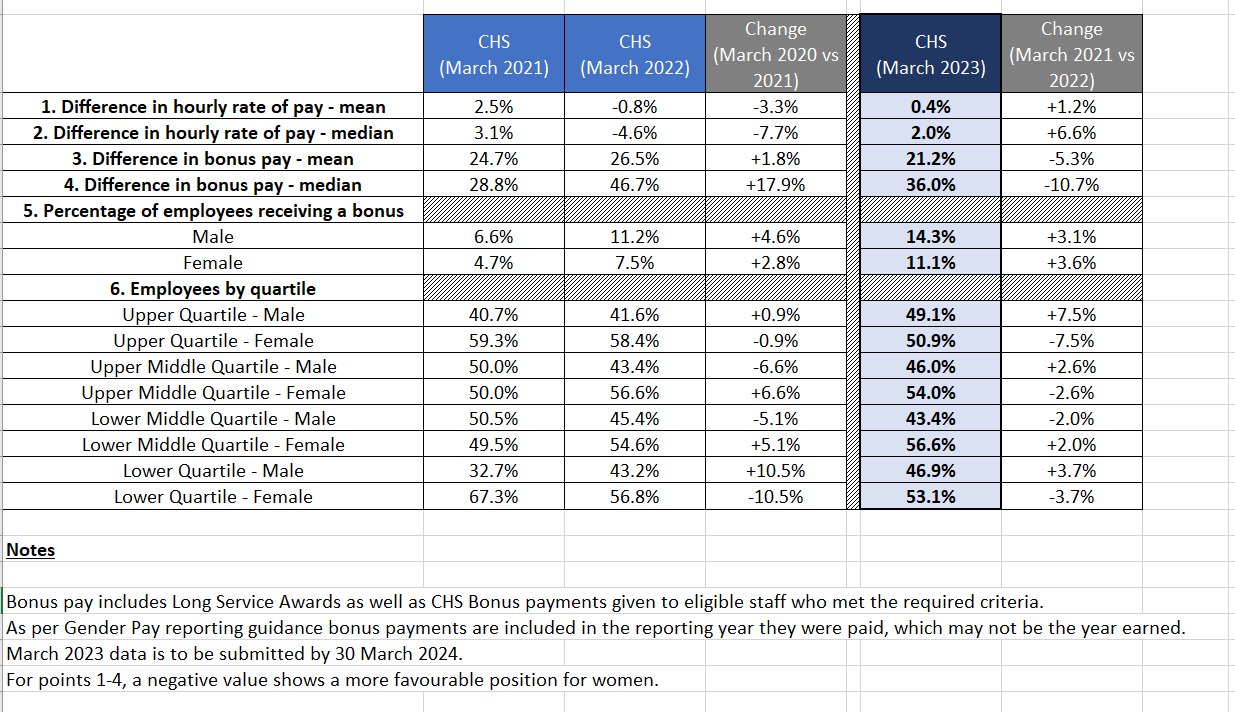Gender Pay Gap Report 2024 (for submission March 2025)
Employee headcount: 250 to 499 employees
Person responsible: Stuart Sugarman (Managing Director)
1. Context
It became mandatory on 31 March 2017 for public sector organisations with more than 250 employees to report annually on their gender pay gap. We are registered with the Government Equalities Office enabling us to submit data on to the website.
The gender pay gap shows the difference between the average (mean or median) earnings of men and women. This is expressed as a percentage of men’s earnings.
The gender pay gap differs from equal pay. Equal pay deals with the pay differences between men and women who carry out the same jobs, similar jobs or work of equal value. It is unlawful to pay people unequally because they are a man or a woman.
The Equality and Human Rights Commission (EHRC) is responsible for monitoring how public bodies are complying with the gender pay gap reporting requirements and can take enforcement action.
The pay data analysed to produce this submission is obtained from the Electronic Staff Record (ESR) Business Intelligence reporting suite using gender pay gap dashboards constructed nationally. Long service award monetary values are calculated outside of ESR.
The data will appear on our own website and through the Government online reporting service as part of its mandatory publication scheme.
2. What is reported?
Employers within the scope of the Equality Act 2010 (Gender Pay Gap Information) Regulations 2017 (the Regulations) must carry out calculations using ‘ordinary pay’ in respect of the gender pay gap and ‘bonus pay’ in respect of the bonus pay gap.
Ordinary pay is defined as:-
- basic pay
- paid leave, including annual, sick, maternity, paternity, adoption or parental leave (except where an employee is paid less than usual or nothing because of being on leave)
- area and other allowances
- shift premium pay, defined as the difference between basic pay and any higher rate paid for work during different times of the day or night
- pay for piecework.
It does not include:-
- overtime payments
- redundancy or termination of employment payments
- payments in lieu of leave
- salary sacrifice
- remuneration provided otherwise than in money
Bonus pay is defined as:-
Any remuneration that is in the form of money, vouchers, securities or options and relates to profit sharing, productivity, performance, incentive or commission.
Bonus pay includes:-
- Payments above the level of ordinary for performance or expertise such as performance related pay for very senior managers and others.
- Long Service Awards, where a monetary payment is made.
- The CHS £500 award for eligible staff in respect of attendance
For each employee who receives a bonus, organisations need to add together all bonus pay received by employees in the 12 month period ending on 31 March each year.
3. About Median and Mean
The median gender pay gap figure
This is the difference between the hourly pay of the median man and the hourly pay of the median woman. The median for each is the man or woman who is in the middle of a list of hourly pay ordered from highest to lowest paid.
A median involves listing all of the numbers in numerical order. If there is an odd number of results, the median is the middle number. If there is an even number of results, the median will be the mean of the two central numbers.
Medians are useful to indicate what the ‘typical’ situation is. They are not distorted by very high or low hourly pay (or bonuses). However, this means that not all gender pay gap issues will be picked up. They could also fail to pick up as effectively where the gender pay gap issues are most pronounced in the lowest paid or highest paid employees.
The mean (average) gender pay gap figure
The mean gender pay gap figure uses hourly pay of all employees to calculate the difference between the mean hourly pay of men, and the mean hourly pay of women.
A mean involves adding up all of the numbers and dividing the result by how many numbers were in the list.
Mean averages are useful because they place the same value on every number they use, giving a good overall indication of the gender pay gap. But very high or low hourly pay can ‘dominate’ and distort the figure.
4. About pay quaters
Pay quarters show the percentage of men and women employees in four equal sized groups based on their hourly pay.
Pay quarters give an indication of women's representation at different levels of the organisation.
5. CHS reporting 2023 (Appendix 1)
Key points
- Mean and median show only very minimal difference between standard hourly rates of pay between male and female colleagues; a slight worsening mean position and a slightly improved median.
- Bonus pay differences have worsened in terms of mean and remained the same for median compared to 2023.
- Continued increases to the proportion of both male and female colleagues receiving a bonus in 2024; though the number of males receiving a bonus has climbed faster, increasing the gap from 3.2% to 4.6%.
- Male colleagues 1.32 x more likely to get a bonus than a female colleagues, a slightly worsening position from 2023 where it was 1.3 x.
- Quartile splits largely indicating parity between genders in the highest and lowest quartiles.
- The upper middle quartile has seen a significant increase in the proportion of females compared to previous years.

Debbie Grundy HR Business Partner
February 2025
